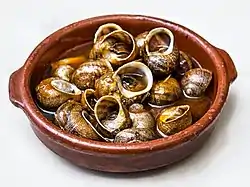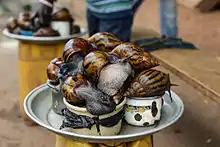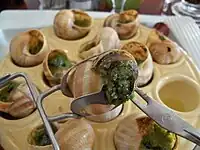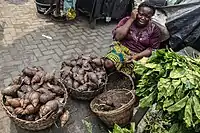

Snails are considered edible in many areas such as the Mediterranean region, Africa, or Southeast Asia, while in other cultures, snails are seen as a taboo food. In American English, edible land snails are also called escargot, taken from the French word for "snail",[1] and the production of snails for consumption is called snail farming or heliciculture. Snails as a food date back to ancient times, with numerous cultures worldwide having traditions and practices that attest to their consumption.
The snails are collected after the rains and are put to "purge" (fasting). In the past, the consumption of snails had a marked seasonality, from April to June.[2] However, thanks to snail breeding techniques, today they are available all year round. Heliciculture occurs mainly in Spain, France, and Italy, which are also the countries with the greatest culinary tradition of the snail.[3] Although throughout history the snail has had little value in the kitchen because it is considered "poverty food", in recent times it can be classified as a delicacy thanks to the appreciation given to it by haute cuisine chefs.[4][5]
Etymology of escargot
Escargot, French pronunciation: [ɛskaʁɡo] ⓘ, comes from the French word for snail. One of the first recorded uses of the French word escargot, meaning dates from 1892. The French word (1549) derives from escaragol (Provençal) and thence escargol (Old French), and is ultimately – via Vulgar Latin coculium and Classical Latin conchylium – from the Ancient Greek konchylion (κογχύλιον), which meant "edible shellfish, oyster". The Online Etymological Dictionary writes, "The form of the word in Provençal and French seem to have been influenced by words related to the scarab."[6][7]
History
Researchers have not been able to pinpoint when humans began consuming snails, although archaeological discoveries point to earlier stages than the invention of hunting. A lot of broken snail shells have been found in the Franchthi Cave, in the Greek Argolis, from the year 10,700 BCE. In Historia de gastronomía (2004), Fernández-Armesto points out the possible reasons: snails are easy to handle, and their cultivation "seems like a natural extension of harvesting".[8]
It is difficult to go beyond the limits of a developmentalist and progressive model of the history of food, according to which it is unthinkable that no food was cultivated in such early times, but snail farming is so simple, requires so little technical effort and is conceptually so close to harvesting methods, that it seems doctrinaire to the point of stubbornness to exclude such a possibility.
- – Felipe Fernandez-Armesto.[8]
Many sites in the Zagros Mountains of Iraq and the Kermanshah region of western Iran are from the late Pleistocene and include snail shells that have been interpreted as food debris.[9] Specifically, these species were mainly Helix salomonica or Levantina spiriplana. The deposits with snails from the ancient Capsian culture (present-day Tunisia) are of notable importance, as well as those found in the Cantabrian Mountains, the Pyrenees and the northern Adriatic (present-day Croatia and Slovenia), in addition to many other remains of snails throughout the Mediterranean Basin.[10][11] The most convincing evidence for prehistoric land snail consumption is found in the Maghreb, beginning in the Iberomaurusian (20,000 BP) and continuing through the Capsian to at least 6,000 BP.[12] Outside the Mediterranean region, the occurrence of land snails as food debris is less common. According to Lubell (2004b), archaeological remains of land snails have been found in the Caribbean, Peru, Texas and other parts of North America, East Africa, Sudan, Nigeria, and the Philippines. Also, archaeological remains of freshwater snails have been found in Yunnan.
In ancient China, in The Book of Rites, a Confucian text, there is a mention of a snail sauce. [13]
Ancient Rome
The Romans considered escargots an elite food, as noted in the writings of Pliny the Elder. The Roman breeder Quintus Fulvius Lippinus is considered the "father" of heliciculture, or at least, the first written reference to snail farms. Lippinus established his study center in the Tuscan city of Tarquinia to feasibly domesticate various animals, such as dormouse and wild boar, among many others. However, he was best known for his enormous snails, of which he had several species brought from Illyria to Africa. With a fatty diet he devised to fatten them, he obtained large quantities of snails, which he then marketed in Rome. His snails set the trend among the Roman upper class, and the practice became popular. Lippinus was an innovator who managed a large company that marketed his snails beyond the Mare Nostrum.[n. 1] In De re coquinaria, one of the complete Roman cookbooks, four recipes based on snails are mentioned.[14] Shells of the edible species Cernuella virgata and Otala lactea have been recovered from the Roman-era city Volubilis, in present-day Morocco. They are a harbinger of the escargot found in modern souks of the country.[15]
Modern Age
Pope Pius V, who was an avid eater of snails, decided that they had to be considered as fish to continue eating them during Lent, exclaiming: Estote pisces in aeternum! ("you will be fish forever!").[16] In Spain, the custom continued to have continuity as can be seen in the gastronomic literature of that time. In the Libro del arte de cozina by Diego Granado, head chef of the Spanish royal household, a section was dedicated to the snail, explaining its biological characteristics, how to clean it, and various recipes on how to cook it, fry it, etc. Curiously, this book was published in 1614 in Lérida, a city in western Catalonia famous for its culinary tradition of the snail.[17]
In the stricter Orthodox Church tradition of fasting, snails are still considered fully Lenten, being invertebrates, and are historically and presently popular.[18]
Species
Not all land snails are edible since many are too small—not worthwhile to prepare and cook—and the palatability of the flesh varies among species.
From the genus Helix:
- Helix lucorum, European snail
- Helix pomatia, Roman snail or Burgundy escargot, is the most consumed species in France
- Helix salomonica
From the family Achatinidae:
- Lissachatina fulica (formerly Achatina fulica), giant African snail, is very popular.
From the genus Cepaea:
- Cepaea nemoralis, grove snail, known as rayado ('striped' snail) in Spain
- Cepaea hortensis, white-lipped snail
From the genus Otala:
- Otala punctata, known as cabrilla in Spain, are bigger
- Otala lactea, Spanish snail
From the genus Pomacea:
- Pomacea canaliculata, apple snail, although native to South America, is widely consumed in Asia and is considered a highly invasive species
- Pomacea urceus, in Colombia and Venezuela, where it originates, is known as guarura
Others:
- Buccinum undatum, common whelk
- Cantareus apertus (formerly Helix aperta), garden snail
- Cornu aspersum (formerly Helix aspersa), common or garden snail, known as petit-gris in France
- Elona quimperiana, known as Escargot de Quimper in France and caracol moteado in the north of Spain
- Littorina littorea, common periwinkle
- Pachychilus sp. are consumed as food amongst the Maya
- Persististrombus latus, known as bilolá in Fang, kolobwidjo in Yoruba and búzio cabra in Cape Verdean Portuguese
Nutrition
| Nutritional value per | |
|---|---|
| Energy | 377 kJ (90 kcal) |
2 | |
| Sugars | 0 |
| Dietary fibre | -- |
1.4 | |
16.1 | |
| Vitamins | Quantity %DV† |
| Vitamin A equiv. | 13% 100 μg |
| Thiamine (B1) | 1% 0.01 mg |
| Riboflavin (B2) | 10% 0.12 mg |
| Niacin (B3) | 9% 1.4 mg |
| Vitamin B6 | 10% 0.13 mg |
| Vitamin B12 | 21% 0.5 μg |
| Vitamin C | 0% 0 mg |
| Vitamin D | 0% 0 IU |
| Vitamin E | 33% 5 mg |
| Vitamin K | 0% 0.1 μg |
| Minerals | Quantity %DV† |
| Calcium | 1% 10 mg |
| Copper | 20% 0.4 mg |
| Iron | 27% 3.5 mg |
| Magnesium | 70% 250 mg |
| Phosphorus | 39% 272 mg |
| Potassium | 8% 382 mg |
| Selenium | 39% 27.4 μg |
| Sodium | 5% 70 mg |
| Zinc | 11% 1 mg |
| Other constituents | Quantity |
| Water | 79.2 |
| |
| †Percentages are roughly approximated using US recommendations for adults. Source: USDA FoodData Central | |
Snail meat has several benefits compared to other meats, highlighting its low calorie and fat content.[19] It is a source of protein (between 10 and 19%). Nutritional information can vary depending on the snail species and on who performs the nutritional analysis.[n. 2] Even so, it can be said that snails are rich in inorganic nutrients: 82% water, minerals such as magnesium and iron (mainly, but also calcium, phosphorus, potassium, and sodium), in addition to a high percentage of niacin (vitamin B3), since for every 100 g of snail meat, up to 55% of the DRI (in women) and 41% DRI (in men).[2] Snails are a good source of selenium. Of the recommended daily requirement of selenium, the snail provides up to 50% (in women) and 30% (in men).[19]
Snail flesh is a good supply of essential amino acids such as lysine, methionine, and cysteine, which are difficult to get in other sources of protein, according to Adeyeye et al. (2020). Scientists also point out that a variety of vitamins, including vitamins A, E, and B12, are present in snail meat and are crucial for maintaining general health and wellbeing.[20]
Due to high iron content, snails are recommended for consumption by people suffering from iron-deficiency anemia.[21] The fat content is low, but provides beneficial omega-3 fatty acids.[19]
Culinary use
Cleaning
Before use in the kitchen, snails must be cleaned to remove impurities.[2] The cleaning process (called purgado in Spanish) consists of leaving them alive for several days without eating, or only eating flour. The flour method is a homemade resource to clean the animal's digestive tract.[22] Formerly in Spain, snails were hung from mesh bags from which they could not escape. Snail chef Morell i Bitrià (1999) recommends not giving them anything to eat for at least eight days (ideally ten or twelve) and then washing them well. Snails that die during the purging process should be disposed of.[23]
Preparation
Snail slime should be removed with as many washes of water as possible, in a colander under running water or in a saucepan. Again they are washed, this time with salt water, which helps cut through the slime.[22] After being cleaned and washed several times, they are transferred to a pot with cold water and salt, and when they emerge from their shells, the heat is raised to the maximum, and they are cooked for approximately a quarter of an hour. After this, they are served in the chosen stew, sauce, or recipe. This intermediate action is popularly known as engañar ("cheating") the snail in Spain, since when they notice a certain heat, they come out of their shells, and once outside the flame is raised so that they die at that moment.[24]
Consumption

In bars where snails are offered as a tapa, it is common for them to be served with toothpicks, as this is the typical rustic utensil for eating snails.[25] A serving commonly ranges between 25 and 30 snails.[5] In haute cuisine-style catering, snails are consumed by grasping the shell with a pince à escargot and extracting the snail with a fork called fourchette à escargot.
.jpg.webp)
On a culinary level, they can be cooked in many ways: stews, baked, a la gormanta, a la brutesque. In the cuisine of Lleida, they are an ingredient in many traditional dishes, in many cases mixed with other meats such as pig's feet, rabbit, chicken, lobsters and prawns, etc.[5]
By region
African Guinea

People in Cameroon, Ghana, Nigeria, and other countries in the area are used to eating African varieties of snail, which are larger. Typical of Equatorial Guinea is a giant sea snail called bilolá (Persististrombus latus), eaten stewed or sautéed, which in Cape Verde is known as búzio cabra, and is grilled on skewers.

Mediterranean Basin
There is a tradition of consuming snails in Andorra, Spain, France, Italy, and Portugal on the European side and Algeria, Morocco, and Tunisia on the African side. Cornu aspersum is the most widespread species in the Mediterranean basin, the Iberian Peninsula, and the French Atlantic coast.
In French cuisine, snails are typically purged, killed, shelled, and cooked (usually with garlic butter, chicken stock or wine), and then placed back into the shells with the butter sauce and additional ingredients, such as garlic, thyme, parsley, or pine nuts. Special tongs for holding the shell and forks for extracting the meat are typically provided. Escargot is served on indented metal trays with places for six or 12 snails.
In Cretan cuisine, the snails are first boiled in white wine with bay leaves, celery, and onion and then coated with flour and fried with rosemary and vinegar.
In Maltese cuisine, snails (Maltese: bebbux) of the petit gris variety are simmered in red wine or ale with mint, basil and marjoram. The snails are cooked and served in their shells.
In Moroccan cuisine, snails also called Ghlal, are a popular street food. They are cooked in a jar filled with hot water, special spices, and herbs. After cooking, Moroccan snails are served in small bowls with broth and consumed hot. Moroccan snails are mostly enjoyed during winter as they are believed to be beneficial for health, especially when dealing with the common cold or rheumatism.[26]
A city known for its snail culture is the town of Lleida, in the north-Spanish region of Catalonia, where the L'Aplec del Caragol festival has been held since 1980, receiving some 300,000 visitors during a weekend in May.[17]
Southeast Asia
Snails are consumed in Cambodia, the Philippines, Indonesia, Laos, Malaysia, Thailand, and Vietnam.
In Indonesia, snails from the rice fields are fried on satay (skewers), a dish known as sate kakul, or grilled Tondano's sate kolombi.
In the west of the island of Java, snails from the rice fields are called tutut and are eaten with various sauces and curries.
Other regions
- Ghonghi is commonly consumed in the Terai region in Nepal.[27]
- Northeast India (states of Manipur, Tripura and Nagaland). In Nagaland, snails are prepared with axone and pork meat, especially fats. Locally it is called 'hamok.' In Manipur, they are called 'tharoi'.
- North India (states of Uttar Pradesh and Bihar). In Bihar, especially in Mithila region, they are called 'doka', at other places in Bihar and eastern Uttar Pradesh, they are called 'ainthi.' They are boiled and the meat is extracted to cook a curry, typically eaten with rice.
- A growing demand in South America, in particular, Argentina, Chile, Peru, and Uruguay.[28]
- Snails are consumed by the Romani people in Europe.[29] Snail soup is a Romani delicacy.[30]
See also
Notes
- ↑ The story of Fulvius Lippinus is documented in the Rerum rusticarum libri III (chapters XII and XIV) by Marcus Terentius Varro, and a century later in the Naturalis Historia (books VIII and IX) by Pliny the Elder.
- ↑ The nutritional information from the USDA database is shown in the nutritional table (it does not indicate which species of snail). Compare to "Calories in Snails (100 g) and Nutrition Facts". FatSecret. (species not indicated). A second USDA study, with different data and without indicating the species, can be consulted here: «Snails, cooked, NS as to cooking method». USDA. And as a reference for this article, the Spanish Ministry of Food data is taken, see Fundación Española de la Nutrición (2019).
External links
References
- ↑ "Escargot". Cambridge Dictionary. Retrieved 2022-06-22.
- 1 2 3 Fundación Española de la Nutrición (2019). "Caracol de tierra" [Land snail] (PDF). Crustáceos y Moluscos (in Spanish). Ministerio de Agricultura, Pesca y Alimentación: 527–528. Retrieved 2022-02-04.
- ↑ Villegas Becerril, Almudena (2014). Cocina española e internacional: arte culinario a través de los productos, recetas e Historia (in Spanish) (1 ed.). Vigo: Ideaspropias. pp. 45–46. ISBN 978-84-9839-470-2. OCLC 898010848.
- ↑ Barbieri, Alberto (2018-04-30). "Alimentos: Caracoles, una larga historia de amor y odio". La Vanguardia (in Spanish). Retrieved 2022-05-28.
- 1 2 3 Morell i Bitrià 1999, p. 12.
- ↑ Harper, Douglas (2016). "Escargot". Online Etymological Dictionary. Retrieved April 9, 2016.
- ↑ Trésor de la Langue Française informatisé
- 1 2 Fernández-Armesto 2004, p. 99.
- ↑ Lubell, David (2004a). "Prehistoric edible land snails in the circum-Mediterranean: the archaeological evidence" (PDF). Petits animaux et sociétés humaines. Du complément alimentaire aux ressources utilitaires. XXIVe rencontres internationales d'archéologie et d'histoire d'Antibe. Antibes: Éditions APDCA: 84–85.
- ↑ MacKinnon, Michael R. (2002). The excavations of San Giovanni di Ruoti. Volume 3, The faunal and plant remains. Alastair Small, Robert J. Buck. Toronto: University of Toronto Press. ISBN 978-1-4426-8123-1. OCLC 647736476.
- ↑ Lubell, David (2004-12-31). "Are land snail a signature for the Mesolithic-Neolithic transition". Documenta Praehistorica. 31: 1–24. doi:10.4312/dp.31.1. ISSN 1854-2492.
- ↑ Lubell 2004, p. 4b.
- ↑ Li Chi: Book of Rites: An Encyclopedia of Ancient Ceremonial Usages, Religious Creeds, and Social Institutions. University Books. 1967.
- ↑ Villegas Becerril, Almudena (2011). Gastronomía romana y dieta mediterránea: el recetario de Apicio (in Spanish). Bloomington: Palibrio. ISBN 978-1-61764-138-1. OCLC 744601447.
- ↑ Hogan, C. Michael. Volubilis, The Megalithic Portal, ed. Andy Burnham (2007) megalithic.co.uk
- ↑ Cattaneo-Vietti, Riccardo; Doneddu, Mauro; Trainito, Egidio (2016-02-04). Man and Shell Molluscs in the History. Bentham Science Publishers. pp. 48. ISBN 978-1-68108-225-7.
{{cite book}}: CS1 maint: date and year (link) - 1 2 Morell i Bitrià 1999, p. 5.
- ↑ Oberhelman, Steven M. (2020-07-06). Healing Manuals from Ottoman and Modern Greece: The Medical Recipes of Gymnasios Lauriōtis in Context. Walter de Gruyter GmbH & Co KG. ISBN 978-3-11-066443-0.
- 1 2 3 "Valor nutricional de caracoles" [nutritional value of snails]. Touchstone Snails, Helicicultura Comercial (in Spanish). 2017-06-27. Retrieved 2022-02-04.
- ↑ Adeyeye, Samuel Ayofemi Olalekan; Bolaji, Olusola Timothy; Abegunde, Titilope Adebusola; Adesina, Taofeek Olawale (2020-01-01). "Processing and utilization of snail meat in alleviating protein malnutrition in Africa: a review". Nutrition & Food Science. 50 (6): 1085–1097. doi:10.1108/NFS-08-2019-0261. ISSN 0034-6659. S2CID 213550199.
- ↑ "Caracoles". Alimentos (in European Spanish). 2009-04-27. Retrieved 2022-06-21.
- 1 2 Sánchez 2017.
- ↑ Cano, Julio César (2004). "Los caracoles. Ingredientes para hacer una buena caracolada". La cocina charnega (in Spanish) (1 ed.). Barcelona: Grup 62. p. 60. ISBN 84-8307-619-5. OCLC 55844574.
- ↑ Cano 2004, p. 61.
- ↑ García, Mario Corral (2019-08-25). "A caracoles". ElDiario.es (in Spanish). Retrieved 2022-05-28.
- ↑ "Top 10 Best Moroccan Street Food You Must Try - MoroccanZest". Moroccan Zest. 2018-09-03. Retrieved 2018-09-29.
- ↑ "8 popular ethnic food items in Nepal". OnlineKhabar. 2021-04-10. Retrieved 2022-12-29.
- ↑ "El caracol en la gastronomía". Cocina y Vino (in European Spanish). 2016-10-25. Retrieved 2022-06-21.
- ↑ We are the Romani People. p. 80.
- ↑ Goce Nikolovski. Taste of Romani (Gypsy) Cuisine.